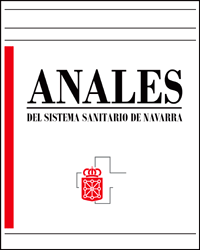Métodos utilizados en la identificación del virus de papiloma humano
DOI:
https://doi.org/10.23938/ASSN.0534Palabras clave:
VPH. Cáncer cervical. Tipificación viralResumen
Dada la relación causal establecida entre tipos específicos de VPH con el cáncer cervical y lesiones precursoras, es importante la identificación del tipo viral involucrado. La tipificación se realiza mediante diversos métodos que varían en sensibilidad y especificidad, cuya utilización depende, principalmente, del objetivo perseguido y de las características de la muestra evaluada. La tipificación del VPH no sólo es importante clínicamente para el seguimiento y establecimiento del tratamiento a un paciente dado; además permite conocer los tipos virales que circulan en una población, lo que es de interés en el desarrollo de programas de prevención y tratamiento de esta enfermedad. Este trabajo es una revisión sobre métodos utilizados en la detección e identificación del VPH en lesiones de cáncer de cuello uterino, resaltando sus características de sensibilidad y especificidad.Descargas
Citas
1. DIESTRO TEJEDA MD, SERRANO VELASCO M, GÓMEZ-PASTRANA NIETO F. Cáncer de cuello uterino. Estado actual de las vacunas frente al VPH. Oncología 2007; 30: 42-59.
https://doi.org/10.4321/S0378-48352007000200002
2. National Cancer Institute. HPV (Human papillomavirus) Vaccines for Cervical Cancer 2007. Disponible on line en:
http://www.cancer.gov/cancertopics/hpv-vaccines.
Consultada en septiembre 2007.
3. BOSCH FX, DE SANJOSÉ S, CASTELLSAGUÉ X. Virus de papiloma humano: riesgo oncogénico y nuevas oportunidades para la prevención. An Sist Sanit Navar 2001; 24: 7-14.
4. CAÑADAS MP, LLOVERAS B, LORINCZ A, EJARQUE M, FONT R, BOSCH FX et al. Evaluación de las técnicas de detección del VPH en los programas de cribado para cáncer de cuello uterino. Salud Publica Mex 2006; 48: 373-378.
https://doi.org/10.1590/S0036-36342006000500003
5. MELO A, ROA I, MONTENEGRO S, CAPURRO I, ROA J. Estudio comparativo de detección del virus papiloma humano (VPH) en muestras citológicas y biopsias de cuello uterino. Rev Méd Chile 2005, 133: 639-644.
https://doi.org/10.4067/S0034-98872005000600003
6. CORRENTI M, CAVAZZA ME, BAJARES M, BELLO J, CERRUTI R, ACOSTA H et al. Detección de virus papiloma humano (VPH) mediante biología molecular y su asociación con neoplasia cervical uterina. Rev Venez Oncol 1997; 9: 76-83.
7. RENSHAW AA, YOUNG NA, BIRDSONG GG, STYER PE, DAVEY D, MODY DR et al. Comparison of performance of conventional and ThinPrep gynecologic preparations in the college of American pathologists gynecologic cytology program. Arch Pathol Lab Med 1997; 128: 17-22.
https://doi.org/10.5858/2004-128-17-COPOCA
8. FRANCO EL, ROHAN TE, VILLA LL. Epidemiologic evidence and human papillomavirus infection as a necessary cause of cervical cancer. J Natl Cancer Inst 1999; 91: 506-511.
https://doi.org/10.1093/jnci/91.6.506
9. MANOS MM, KINNEY WK, HURLEY LB, SHERMAN ME, SHIEH-NGAI J, KURMAN RJ et al. Identifying women with cervical neoplasia: using human papillomavirus DNA testing for equivocal Papanicolaou results. JAMA 1999; 281: 1605-1610.
https://doi.org/10.1001/jama.281.17.1605
10. WHEELER C, HUNT WC, SCHIFFMAN M, CASTLE PE. Human papillomavirus genotypes and the cumulative 2-year risk of cervical precancer. J Infect Dis 2006; 194: 1291-1298.
https://doi.org/10.1086/507909
11. ESKRIDGE C, BEGNEAUD W, LANDWEHR C. Cervicography combined with repeat Papanicolaou test as triage for low grade cytologic abnormalities. Obstet Gynecol 1998; 92: 351-355.
https://doi.org/10.1097/00006250-199809000-00006
12. CASTLE PE, SOLOMON D, SCHIFFMAN M, WHEELER CM. Human papillomavirus type 16 infections and 2-year absolute risk of cervical precancer in women with equivocal or mild cytologic abnormalities. J Natl Cancer Inst 2005; 97: 1066-1071.
https://doi.org/10.1093/jnci/dji186
13. CAÑADAS MP, LLOVERAS B, LORINCZ A, EJARQUE M, FONT R, BOSCH FX et al. Evaluación de las técnicas de detección del VPH en los programas de cribado para cáncer de cuello uterino. Salud Pública Mex 2006; 48: 373-378.
https://doi.org/10.1590/S0036-36342006000500003
14. COX T, CUZICK J. HPV DNA testing in cervical cancer screening: from evidence to policies. Gynecol Oncol 2006; 103: 8-11.
https://doi.org/10.1016/j.ygyno.2006.07.030
15. CUZICK J, CLAVEL C, PETRY KU, MEIJER CJ, HOYER H, RATNAM S et al. Overview of the european and north american studies on HPV testing in primary cervical cancer screening. Int J Cancer 2006; 119: 1095-1101.
https://doi.org/10.1002/ijc.21955
16. PUIG-TINTORÉ LM. Utilización del test de VPH en el cribado primario del cáncer de cérvix. XVIII Congreso de la AEPCC. Granada 2006.
Disponible on line en:
http://www.aepcc.org/download/congresos/xviii/ponencias/GR_S1-5.pdf Consultada en enero 2008.
17. Roche Molecular Diagnostic.
http://molecular.roche.com (última consulta 29 de octubre de 2009).
18. Inmunolab. Investigación Biomédica.
http://www.inmunolab.com/ (última consulta 29 de octubre de 2009).
19. Roche. Roche España.
http://www.rochediagnostics.es (última consulta 29 de octubre de 2009)
20. Qiagen. Ample and Assay Technologies.
http://www1.qiagen.com/Products/digeneHPVTesthc2.aspx#Tabs=t1
(última consulta 29 de octubre de 2009).
21. SCHIFFMAN M, WHEELER CM, DASGUPTA A, SOLOMON D, CASTLE PE. A comparison of a prototype PCR assay and hybrid capture 2 for detection of carcinogenic human papillomavirus DNA in women with equivocal or mildly abnormal papanicolaou smears. Am J Clin Pathol 2005, 124: 722-732.
https://doi.org/10.1309/E067X0L1U3CY37NW
22. DE FRANCESCO MA, GARGIULO F, SCHREIBER C, CIRAVOLO G, SALINARO F, MANCA N. Comparison of the AMPLICOR human papillomavirus test and the hybrid capture 2 assay for detection of high-risk human papillomavirus in women with abnormal PAP smear. J Virol Methods 2008; 147: 10-17.
https://doi.org/10.1016/j.jviromet.2007.07.023
23. SANDRI MT, LENTATI P, BENINI E, DELL'ORTO P, ZORZINO L, CAROZZI FM et al. Comparison of the digene HC2 assay and the Roche AMPLICOR human papillomavirus (HPV) test for detection of high-risk HPV genotypes in cervical samples. J Clin Microbiol 2006, 44: 2141-2146.
https://doi.org/10.1128/JCM.00049-06
24. MONSONEGO J, BOHBOT JM, POLLINI G, KRAWEC C, VINCENT C, MERIGNARGUES I et al. Performance of the Roche AMPLICOR HPV test in prediction of cervical intraepithelial neoplasia in women with abnormal PAP smear. Gynecol Oncol 2005, 99: 160-168.
https://doi.org/10.1016/j.ygyno.2005.05.030
25. VAM HAM MA, BAKKERS JM, HARBERS GK, QUINT WG, MASSUGER L, MELCHERS W. Comparison of two commercial assays for detection of HPV in cervical scrape specimens: validation of the Roche Amplicor HPV test as a means to screen for HPV genotypes associated with higher risk of cervical disorders. J Clin Microbiol 2005; 43: 2662-2667.
https://doi.org/10.1128/JCM.43.6.2662-2667.2005
26. VAN DOORN LJ, QUINT W, KLETER B, MOLIJN A, COLAU B, MARTIN MT et al. Genotyping of human papillomavirus in liquid cytology cervical specimens by the PGMY line blot assay and the SPF10 line probe assay. J Clin Microbiol 2002; 40: 979-983.
https://doi.org/10.1128/JCM.40.3.979-983.2002
27. GIULIANI L, COLETTI A, SYRJÄNEN K, FAVALLI C, CIOTTI M. Comparison of DNA sequencing and Roche Linear array in human papillomavirus (HPV) genotyping. Anticancer Res 2006; 26: 3939-3941.
28. GINOCCHIO CC, BARTH D, ZHANG F. Comparison of the third wave invader Human papillomavirus (HPV) assay and the digene HPV hybrid capture 2 assay for detection of high-risk HPV DNA. J Clin Microbiol 2008; 46: 1641-1646.
https://doi.org/10.1128/JCM.01824-07
29. WONG AK, CHAN RC, NICHOLS S, BOSE S. Human papillomavirus (HPV) in atypical squamous cervical cytology: the Inv HPV test as a new screening assay. J Clin Microbiol 2008; 46: 869-875.
https://doi.org/10.1128/JCM.01424-07
30. SCHIFFMAN M, SOLOMON D. Findings to date from the ASCUS-LSIL triage study (ALTS). Arch Pathol Lab Med 2003; 127: 946-949.
Descargas
Publicado
Cómo citar
Número
Sección
Licencia

Esta obra está bajo una licencia internacional Creative Commons Atribución-CompartirIgual 4.0.
La revista Anales del Sistema Sanitario de Navarra es publicada por el Departamento de Salud del Gobierno de Navarra (España), quien conserva los derechos patrimoniales (copyright ) sobre el artículo publicado y favorece y permite la difusión del mismo bajo licencia Creative Commons Reconocimiento-CompartirIgual 4.0 Internacional (CC BY-SA 4.0). Esta licencia permite copiar, usar, difundir, transmitir y exponer públicamente el artículo, siempre que siempre que se cite la autoría y la publicación inicial en Anales del Sistema Sanitario de Navarra, y se distinga la existencia de esta licencia de uso.








